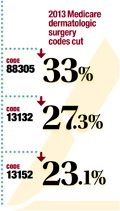- Acne
- Actinic Keratosis
- Aesthetics
- Alopecia
- Atopic Dermatitis
- Buy-and-Bill
- COVID-19
- Case-Based Roundtable
- Chronic Hand Eczema
- Chronic Spontaneous Urticaria
- Drug Watch
- Eczema
- General Dermatology
- Hidradenitis Suppurativa
- Melasma
- NP and PA
- Pediatric Dermatology
- Pigmentary Disorders
- Practice Management
- Precision Medicine and Biologics
- Prurigo Nodularis
- Psoriasis
- Psoriatic Arthritis
- Rare Disease
- Rosacea
- Skin Cancer
- Vitiligo
- Wound Care
Article
Dermatologists take 'hammering' with cuts to three reimbursement codes
Federal regulators are more closely scrutinizing some dermatologic surgery codes, including those that are considered the “bread and butter” for skin cancer repairs. And codes that are deemed misvalued could be cut by as much as one-third by Medicare. Commercial carriers could follow suit.

Dr. Dinehart
Federal regulators are more closely scrutinizing some dermatologic surgery codes, including those that are considered the “bread and butter” for skin cancer repairs. And codes that are deemed misvalued could be cut by as much as one-third by Medicare. Commercial carriers could follow suit.
Scott Dinehart, M.D., expected Medicare would announce cuts to reimbursement codes that dermatologists commonly use. But the Little Rock, Ark., dermatologist says he didn’t anticipate the specialty taking what he calls “a hammering.”
Three codes - 88305, 13132 and 13152 - are widely used in dermatology. And experts say Medicare’s cuts are only the beginning. Commercial carriers will likely follow, implementing changes in 2013.

The changes
According to Dr. Dinehart, who is chairman of the American Academy of Dermatology’s healthcare finance committee and past chairman of the academy’s coding and reimbursement task force, says 88305 is the pathology code that most dermatologists use.
“Basically, Medicare is going to start paying one-third less for that code, starting Jan. 1 (2013),” Dr. Dinehart says. “Twenty-five percent of dermatologists have pathology labs - so, it’s not just dermatopathologists. And if that gets cut 33 percent and their overhead is 50 percent, that’s a 60 percent income reduction for them.”
Medicare is reducing reimbursement for 13132, a code for complex closures on the face (excluding the nose) by 27.3 percent.
“It’s a very common complex repair,” Dr. Dinehart says. “You could say if you’re a nonsurgical dermatologist this doesn’t affect you that much. But dermatologists, in general, do quite a few complex closures.”
Another complex closure code and one that covers closures on the ears and nose, is 13152, which sustained a 23.08 percent reduction.
Dr. Dinehart says he’ll feel the financial effects of all three.
“Our practice has its own derm/path lab, and I’m a Mohs surgeon who does a lot of repairs,” he says.

Dr. Geist
David E. Geist, M.D., a dermatologic surgeon and assistant professor of dermatology, University of Massachusetts School of Medicine, Worcester, Mass., says 13132 and 13152 are the bread and butter codes for skin cancer repair. Dr. Geist, who chairs the academy’s coding and reimbursement task force, says he uses these codes often.
“I think the unfortunate thing about the way that CMS (Centers for Medicare and Medicaid Services) looks at this, sometimes, is that because something is being used a lot doesn’t mean that it is being overused. There are other ways to fix some of these defects, including flaps and skin grafts, that are more resource intensive,” Dr. Geist says.
Why, oh why?
According to a response to Dermatology Times from CMS, the changes to 88305 apply to surgical pathology generally - not dermatology specifically. CPT code 88305 is among several hundred services that have been identified as “misvalued,” which makes it is a government target for examination, according to the Affordable Care Act.
The interim final values in the final rule reflect the direct practice expense (PE) inputs recommended by the American Medical Association/Specialty Society Relative Value Scale Update Committee (RUC), with refinements CMS made to ensure that certain costs were not duplicated in the payment methodology.
“Items not accepted by CMS amounted to less than 10 percent of previous direct costs for CPT code 88305. The AMA/RUC recommended direct inputs for specimen disposal, courier transport and computer systems and software. CMS considers these costs to be indirect that are separately recognized in the indirect cost portion of the practice expense methodology or equipment maintenance costs that are already built into the equipment cost per minute calculation,” according to CMS.
The AAD’s RUC adviser Brett Coldiron, M.D., says the American Academy of Dermatology Association (AADA) and the College of American Pathologists presented to the AMA/RUC in January 2012, and, “indeed did not support the current levels of reimbursement for the preparation of pathology slides.”
Clay J. Cockerell, M.D., clinical professor of dermatology and pathology at the University of Texas Southwestern Medical Center, Dallas, says the catalyst for the evaluation of this code came from published articles suggesting it costs $18 to make a slide.
“CMS used this as a benchmark number, even though many disagree strongly as to this value. Furthermore, an article published about prostate biopsies, which also fall under 88305, demonstrated overutilization. … Businesses have sprung up in the last number of years advertising that physicians can generate significant income by setting up in-office labs and, ultimately, CMS acted in part in an effort to curtail this commercialization of a physician service by cutting the code,” says Dr. Cockerell, who is a member of the academy’s Dermatopathology Rapid Response Committee.
Regarding complex repairs, CMS disagreed with the RUC recommendations for 13152. According to CMS, after reviewing CPT code 13152 (repair, complex, eyelids, nose, ears and/or lips; 2.6 cm to 7.5 cm), CMS believes that relative value units assigned to the code were too high relative to similar CPT codes 13132 and 13151.
Dr. Coldiron says the AADA, the American Academy of Otolaryngology-Head and Neck Surgery and the American Society of Plastic Surgeons presented to the AMA/RUC in April 2012.
“The surveys and comparisons to other codes indicated that some of the complex (repair) codes needed refinement in their value, with a few codes being decreased at the RUC. The RUC suggested changes. CMS has the option of accepting those changes or modifying them. Unfortunately, CMS chose the latter for a few of the complex repair codes by decreasing values beyond the RUC recommendations,” Dr. Coldiron says.
All’s not fair?
Although CMS accepted the majority of the AMA/RUC recommendations on almost 30 dermatology codes surveyed in 2012 - maintaining current payment levels for most and even increasing some - the AADA opposes CMS’s changes in relative value units that are in excess of those recommended by the AMA/RUC, Dr. Coldiron says.
“But even those values recommended by the RUC after a fair and impartial examination of true costs would have resulted in more than a 40 percent decrease in 88305,” he says. “CMS decreased the amount over and beyond that without justification, which is why we will protest the CMS revision. We have reason to believe that CMS still believes these codes are overvalued.”

Dr. Gohara
Physicians are sensitive to escalating health care costs and are willing to work with payers, including CMS, according to Dr. Cockerell. And, while he agrees that 88305 might have been misvalued and even misused by some commercial groups, he disagrees with the degree to which it was considered overvalued.
Dr. Dinehart agrees.
“The problem for practitioners is that significant investments have been made in equipment, supplies, personnel, etc., based upon a certain value for the code. To have the code cut so drastically is difficult because adjustments have to be made quickly, or one simply cannot provide the service (and goes out of business),” Dr. Dinehart says. “With this kind of ‘uncertainty’ about code values … it’s no wonder that doctors do not want to invest in their practices or take any kind of risk.”
Dr. Dinehart says it is his opinion that whenever a code is cut more than 10 percent, there should be a phase-in period over three to five years, so adjustments can be made.
The specialty’s response
In December 2012, the AADA submitted a letter of comment to CMS in response to requirements outlined in the 2013 Physician Fee Schedule final rule, encouraging CMS to adopt the RUC recommendations, according to Dr. Coldiron. Consequences to the specialty could be substantial, he says.
“As (88305) results in essentially a one-third to one-half devaluation of the majority of work that is done in dermatopathology, it will definitely result in layoffs, salary cuts and in some cases, such as dermatologists who are considering opening a laboratory in their office, not proceeding with doing so,” Dr. Cockerell says.
Among other things, Dr. Cockerell predicts labs will attempt to cut costs. Potentially included in those cost-cutting measures: increasing the amount of tissue that can be put into a single block for excisions.
“If expert dermatopathologists who are already in short supply ultimately are forced because of cost issues to stop evaluating Medicare patient biopsies, this could be especially serious,” he says.
What you can do
Acceptance that reimbursement for some services is not what it was is important as dermatologists practice in 2013. Cost-cutting, according to experts, is the wave of the future.
“Just because we have traditionally been reimbursed a certain amount for a certain procedure does not mean that … value will stand up to scrutiny in the relative value system used by the RUC and CMS,” Dr. Coldiron says. “Usage and the presumption of over-usage, whether correct or not, informs a lot of the decisions and criteria that CMS uses to call codes back for examination. In today’s environment, we must continue to endeavor to practice the most appropriate, cost-conscious care.”
Mona Gohara, M.D., who practices in a group of seven dermatologists in Danbury, Conn., and is an assistant clinical professor in dermatology at Yale School of Medicine, says she won’t take a direct hit from the changes because she is not a dermatopathologist nor does she do dermatologic surgery. The changes will affect her financially, however, because the practice offers both services, and the doctors’ resources are pooled, she says.
Still, Dr. Gohara is taking the changes in stride.
“I think healthcare is changing. And although this is something that’s just happening now, I don’t think it’s surprising. And I think it’s going to continue. I’m not doing this for financial reasons. It’s not going to affect the way I approach my patients or my job,” Dr. Gohara says.
Dermatologists who want to get involved can look toward the future, Dr. Coldiron says.
“There are ways in which dermatologists can help determine the rate at which Medicare and other payers value procedures for 2014,” he says.
Among those: Participate in RUC surveys. Dermatologists are randomly selected to participate in these surveys, so be sure to check your email inbox, according to Dr. Coldiron. Another option for dermatologists is to evaluate options for 2014. There are three Medicare contractual options for physicians (Par, non-par and private contracts). For more, visit www.aad.org/member-tools-and-benefits.
Finally, dermatologists should realize things could have been worse. In early January, Congress once again issued a last-minute freeze to proposed 26.5 percent Medicare reimbursement cuts under the sustainable growth rate formula. Had Congress failed to halt the reimbursement reductions, the impact on all dermatologic codes would have been greater, Dr. Coldiron says. DT

Does your practice include a pathology lab?
If so, your income may soon take a hit. Code 88305 could get a 33 percent reimbursement cut by CMS. For derms with labs, whose overhead costs can total 50 percent, the fallout may mean a 60 percent reduction in income, says Scott Dinehart, M.D., former member of AAD's Coding and Reimbursement Task Force.
2013 AAD Coding and Reimbursement Task Force:

Newsletter
Like what you’re reading? Subscribe to Dermatology Times for weekly updates on therapies, innovations, and real-world practice tips.
















